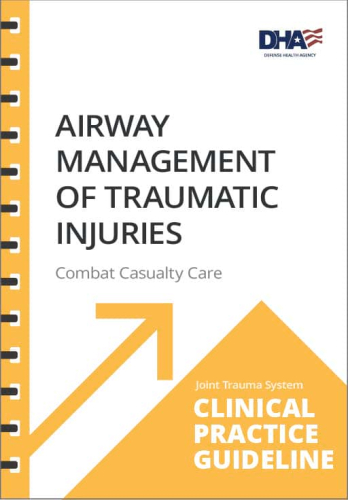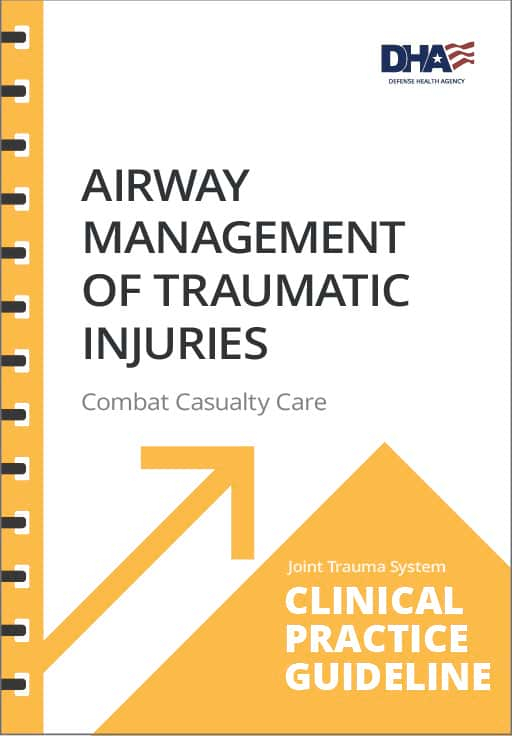Background
Airway obstruction was the second most common cause of potentially survivable death in all US combat casualties from October 2001 to June 2011. Thus, airway management is often a critical early step in the resuscitation of the severely injured trauma patient. Identifying harbingers of a potentially difficult airway, having knowledge of a difficult airway algorithm, and understanding the proper utilization of alternative airway devices will allow for a pre-planned strategy for successful airway management.
Significant Changes
Refer to in Appendix A for Trauma Airway Assessment guidance and Appendix B for Difficult Airway Management.
- Ketamine is the first line agent for Rapid Sequence Intubation (RSI).
- Apply principles of Apneic Oxygenation.
- Utilize device name rather than brand-name wherever possible.
- Eliminate blind nasal intubation. Anticipate fiber optic guidance if available.
- Use waveform or digital capnography as primary tool to verify tube placement if available.
- Remove recommendation for use of an intubating Laryngeal Mask Airway.
- Offer surgical cricothyroidotomy or tracheostomy as surgical airway options.
- Optimize RSI and Intubation Pathway for all patients. Separate Traumatic Brain Injury (TBI) algorithm not required.
- Include specific pediatric recommendations.
- Trauma airway management should be rehearsed with your trauma team on a regular basis to include role assignments and familiarization with difficult airway management and surgical airway equipment.
Performance Improvement (PI) Monitoring
Population of Interest
- All patients who received ETT/cricothyroidotomy/supraglottic airway/NPA
- All patients with compromised airway (initial GCS < 8 or AIS head and neck ≥ 3 or AIS face ≥ 3, arrival/transport or initial ED SpO2 < 90%, arrival/transport or initial ED ETCO2 > 50).
Intent (Expected Outcomes)
- All injured patients who present with obtundation (GCS<8), apnea, respiratory distress or insufficiency, airway obstruction, or impending airway loss will have a secure and definitive airway established expeditiously upon arrival to a Role 2 or Role 3.
- SpO2 is maintained between ≥ 90% and 96%. SpO2 >96% is not necessary.
Performance/Adherence Measures
- Number and percentage of patients in the population of interest who had a secure and definitive airway (endotracheal tube, cricothyroidotomy, tracheostomy) established or verified on arrival to Role 2 or 3, or documentation of appropriate intervention.
- Number and percentage of patients in the population of interest with initial ED SpO2 < 90%, < 80%, <70%, <60%.
- Number and percentage of patients who had definitive airway (endotracheal tube, cricothyroidotomy, tracheostomy) with ETCO2 documented at the same role of care where the procedure is done.
Data Source
- Patient Record
- Department of Defense Trauma Registry (DoDTR)
System Reporting and Frequency
The above constitutes the minimum criteria for PI monitoring of this CPG. System reporting will be performed annually; additional performance improvement monitoring and system reporting may be performed as needed.
The system review and data analysis will be performed by JTS Chief and the JTS PI Branch.
Responsibility
It is the trauma team leader’s responsibility to ensure familiarity, appropriate compliance and PI monitoring at the local level with this CPG.
All Health Care Providers
- Will be familiar with the guidelines for performance of trauma airway management.
- Will be familiar with the guidelines for performance of rapid sequence intubation.
- Will be familiar with alternative airway devices mentioned in guidelines for trauma airway management.
- Will provide feedback and suggested CPG changes to the JTS Director and/or Program Manager.
The Chief, Emergency/Anesthesia/Surgery
At each Level III facility, the chief will coordinate with the JTS Director on the appropriateness of the guidelines being used and provide input for updates on an as needed basis.
The JTS Chief
- Will be the subject matter expert on the trauma airway management CPG to be used in the US Central Command Area of Responsibility.
- Will review annually and update the CPG as-needed.
-
- Eastridge BJ, Mabry RL, Seguin P, et al. Death on the battlefield (2001-2011): implications for the future of combat casualty care. J Trauma Acute Care Surg. 2012 Dec;73(6 Suppl 5):S431-7.
- Levitan R, Wayne P. Guide to Intubation and Practical Emergency Airway Management. Pennsylvania: Airway Cam Technologies, Inc.; 2004.
- Weingart, Levitan. Preoxygenation and prevention of desaturation during emergency airway management, Annals of EM, Vol 59, No 3, March 2012.
- Gofrit et al. Ketamine in the field, Injury Vol 28, No 1, pp 41-43, 1997
- Sehdev et al. Ketamine for RSI in pots with head injury. Emergency Medicine Australasia (2006) 18, 37-44.
- Weingart et al. Delayed Sequence Intubation. Annals of EM, Vol 65, No 4, April 2015
- Griesdale et al, Glidescope vs DL: systematic review and meta-analysis, Can J Anesth (2012) 59:41-52
- McMullan et al. Prevalence of prehospital hypoxemia and oxygen use in trauma patients. MilMed, Vol 178, Oct 2013.
- Wimalasena et al. Apneic oxygenation…. Annals of EM. Vol 65, No 4, April 2015.
- Ellis et al. Cricoid pressure in ED RSI: Risk-Benefit, Annals of EM, Vol 50, No 6: Dec 2007.
- Harris et al. Cricoid pressure and laryngeal manipulation in 402 pre-hospital emergency anesthestics, Resuscitation, 81 (2010) 810-816.
- Seder et al. Emergency Neurological Life Support: Airway, Ventilation, and Sedation. Neurocrit Care (2012) 17:S4-S20.
- Swadron et al. Emergency Neurological Life Support: TBI. Neurocrit Care (2012) 17: S112-S121.
- McGill. Airway Management in Trauma: An Update. Emerg Med Clin N Am 25 (2007) 603-622.
- Defense Health Board, Combat Trauma Lessons Learned from Military Operations of 2001-2013, Mar 9, 2015
- Martin MJ, Beekley A. Front Line Surgery: A Practical Approach. New York: Springer Publishing Inc.; 2011.
- Borden Institute (U.S.). Emergency war surgery. Fourth United States revision. ed.
- Nakstad, Anders R., Per P. Bredmose, and Mårten Sandberg. “Comparison of a percutaneous device and the bougie-assisted surgical technique for emergency cricothyrotomy: an experimental study on a porcine model performed by air ambulance anaesthesiologists.” Scandinavian journal of trauma, resuscitation and emergency medicine 21.1 (2013): 1-8.
- Reardon, Rob, Scott Joing, and Chandler Hill. “Bougie-guided Cricothyrotomy Technique.” Academic Emergency Medicine 17.2 (2010): 225-225.
- Prekker ME, Driver BE, Trent SA, et al. Video versus direct laryngoscopy for tracheal intubation of critically ill adults. N Engl J Med. 2023 Aug 3;389(5):418-429.
Appendix A. Trauma Airway Assessment

Appendix B. Difficult Airway Management Algorithm

Appendix C. Additional Information Regarding Off-Label Uses in CPGs
Purpose
The purpose of this Appendix is to ensure an understanding of DoD policy and practice regarding inclusion in CPGs of “off-label” uses of U.S. Food and Drug Administration (FDA)–approved products. This applies to off-label uses with patients who are armed forces members.
Background
Unapproved (i.e., “off-label”) uses of FDA-approved products are extremely common in American medicine and are usually not subject to any special regulations. However, under Federal law, in some circumstances, unapproved uses of approved drugs are subject to FDA regulations governing “investigational new drugs.” These circumstances include such uses as part of clinical trials, and in the military context, command required, unapproved uses. Some command requested unapproved uses may also be subject to special regulations.
Additional Information Regarding Off-Label Uses In CPGs
The inclusion in CPGs of off-label uses is not a clinical trial, nor is it a command request or requirement. Further, it does not imply that the Military Health System requires that use by DoD health care practitioners or considers it to be the “standard of care.” Rather, the inclusion in CPGs of off-label uses is to inform the clinical judgment of the responsible health care practitioner by providing information regarding potential risks and benefits of treatment alternatives. The decision is for the clinical judgment of the responsible health care practitioner within the practitioner-patient relationship.
Additional Procedures
Balanced Discussion
Consistent with this purpose, CPG discussions of off-label uses specifically state that they are uses not approved by the FDA. Further, such discussions are balanced in the presentation of appropriate clinical study data, including any such data that suggest caution in the use of the product and specifically including any FDA-issued warnings.
Quality Assurance Monitoring
With respect to such off-label uses, DoD procedure is to maintain a regular system of quality assurance monitoring of outcomes and known potential adverse events. For this reason, the importance of accurate clinical records is underscored.
Information to Patients
Good clinical practice includes the provision of appropriate information to patients. Each CPG discussing an unusual off-label use will address the issue of information to patients. When practicable, consideration will be given to including in an appendix an appropriate information sheet for distribution to patients, whether before or after use of the product. Information to patients should address in plain language: a) that the use is not approved by the FDA; b) the reasons why a DoD health care practitioner would decide to use the product for this purpose; and c) the potential risks associated with such use.





















